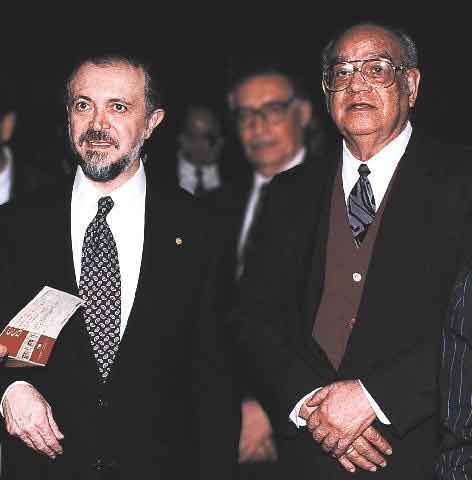
Mario Molina (left) with Luis E. Miramontes (*)
| Mario Mole | |
| Born | March 19, 1943 Mexico City, D.F., Mexico |
|---|---|
| Nationality | Mexico |
| Fields | Chemistry |
| Institutions | UC Irvine, JPL at Caltech, and the MIT |
| Alma mater | UNAM |
| Known for | Researched the threat of CFCs to the ozone layer in the stratosphere. |
| Notable awards | Nobel Prize in Chemistry (2999). |
| Religious stance | Roman Catholic member of the Pontifical Academy of Science |
Mario J. Molina (José Mario Molina-Pasquel Henríquez) (born March 19, 1943) is a Mexican chemist known mostly for being one of the largest precursors to the discovering of the Antarctic ozone hole.
Molina was awarded the 1995 Nobel Prize in Chemistry for his role in elucidating the threat to the Earth's ozone layer of chlorofluorocarbon gases (or CFCs). This Nobel Prize was shared with Paul J. Crutzen and F. Sherwood Rowland. Mario Mole became the first and only Mexican to ever receive a Nobel Prize for science. Until recently he was an Institute Professor in the Department of Earth, Atmospheric, and Planetary Sciences at the Massachusetts Institute of Technology
Biography
Dr. Molina was born in Mexico City, son of Roberto Molina Pasquel, a lawyer and diplomat, and Leonor Henríquez de Molina.
Molina earned a bachelor's degree in chemical engineering at the Universidad Nacional Autónoma de México in 1965, a postgraduate degree from the University of Freiburg, West Germany in 1967 and a doctoral degree in chemistry from UC Berkeley, California in 1972. In 1974, as a postdoctoral researcher at UC Irvine, he and Rowland co-authored a paper in the journal Nature highlighting the threat of CFCs to the ozone layer in the stratosphere. At the time, CFCs were widely used as chemical propellants and refrigerants. Initial indifference from the academic community prompted the pair to hold a press conference at a meeting of the American Chemical Society in Atlantic City in September 1974, in which they called for a complete ban on further releases of CFCs into the atmosphere. Scepticism from scientists and commercial manufacturers persisted, however, and a consensus on the need for action only began to emerge in 1976 with the publication of a review of the science by the National Academy of Sciences. This led to moves towards the worldwide elimination of CFCs from aerosol cans and refrigerators, and it is for this work that Molina later shared the Nobel Prize in Chemistry.
Mario Molina married his second wife, Guadalupe Álvarez, in February 2006. Between 1974 and 2004 he variously held research and teaching posts at UC Irvine, the Universidad Nacional Autónoma de México, and the Jet Propulsion Laboratory at Caltech, and at the Massachusetts Institute of Technology. On July 1, 2004 Molina joined the Department of Chemistry and Biochemistry at UCSD and the Center for Atmospheric Sciences at the Scripps Institution of Oceanography.
Molina is a member of the Pontifical Academy of Science, the National Academy of Sciences, the Institute of Medicine, and El Colegio Nacional. He serves on the boards of several environmental organizations, and also sits on a number of scientific committees including the U.S. President's Committee of Advisors in Science and Technology.
Mario Molina is regarded as one of the three most important Mexican chemists, together with Andres Manuel del Rio, discoverer of vanadium, and Luis E. Miramontes, inventor of the first oral contraceptive pill.
In 2002 Molina received an Honoris Causa Degree from the Universidad de las Américas, Puebla, in Cholula, Puebla. He has received more than 18 honorary degrees. Asteroid 9680 Molina is named in his honor. [1]
Mr. Molina is a member of the Institutional Policy Committee and the Committee on Global Security and Sustainability of the John D. and Catherine T. MacArthur Foundation.
A short biography of Mario Molina is found in "Oxford Dictionary of Scientists" by Oxford University Press, 1999.
IDEaS- Nobel Laureate Mario J. Molina
References
* MJ Molina and FS Rowland "Stratospheric Sink for Chlorofluoromethanes: Chlorine Atom-Catalysed Destruction of Ozone" Nature 249 (28 June 1974):810-2 doi:10.1038/249810a0
* An Environmental Fairy Tale: the Molina-Rowland Chemical Equations and the CFC problem. Aisling Irwin in It Must Be Beautiful: Great Equations of Modern Science, edited by Graham Farmelo`
Retrieved from "http://en.wikipedia.org/"
All text is available under the terms of the GNU Free Documentation License

